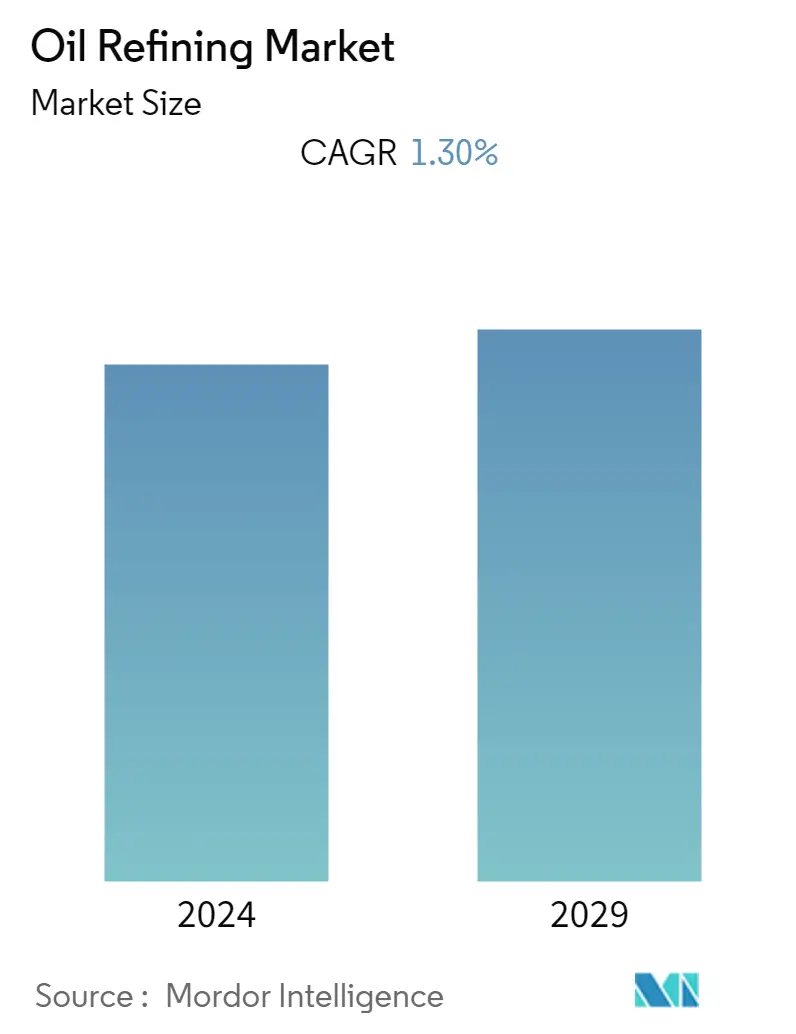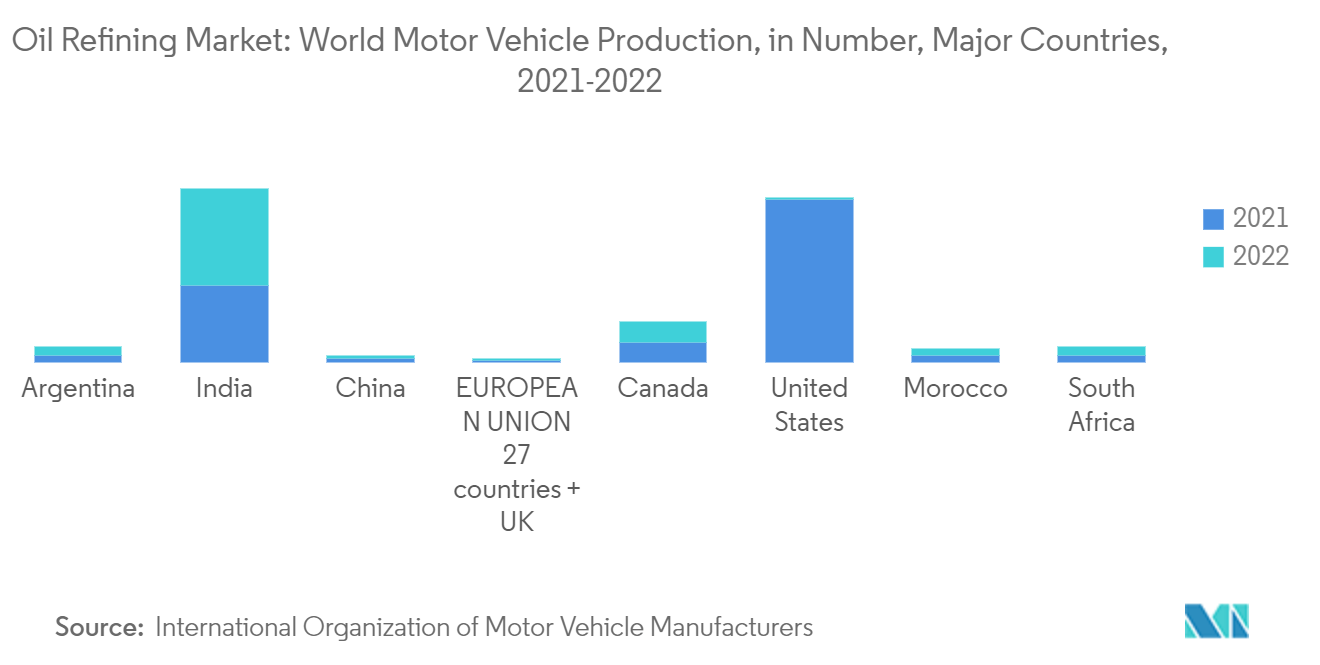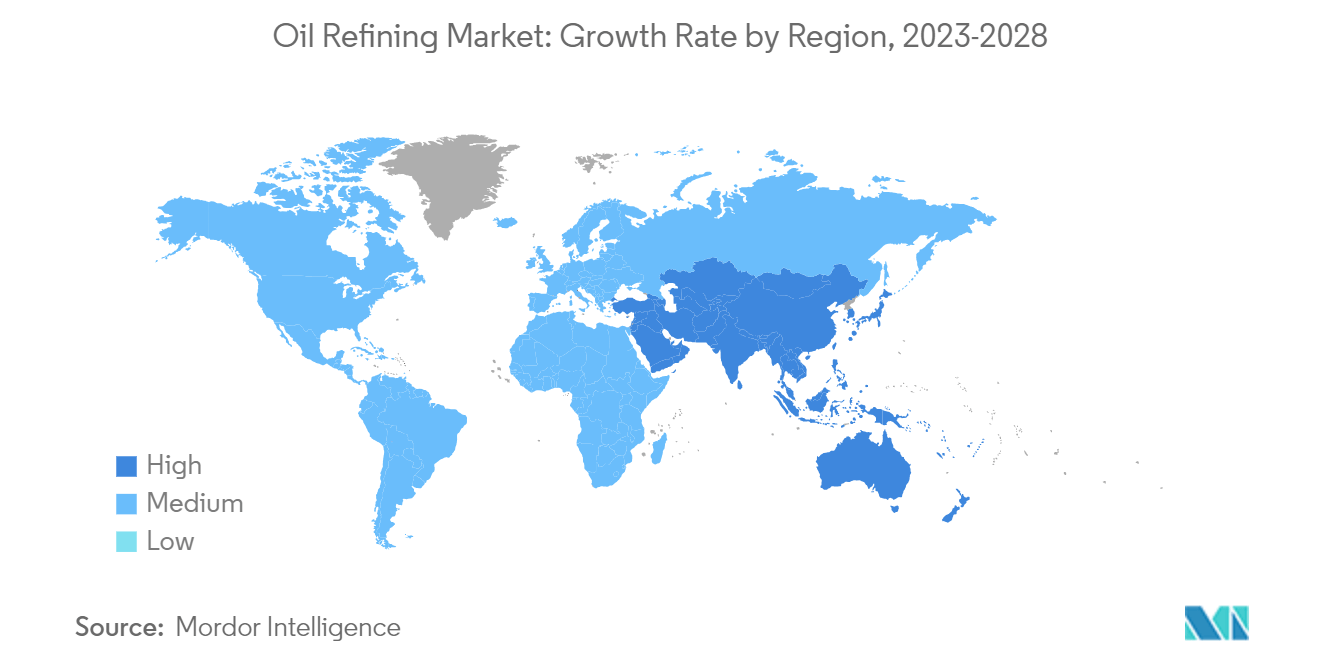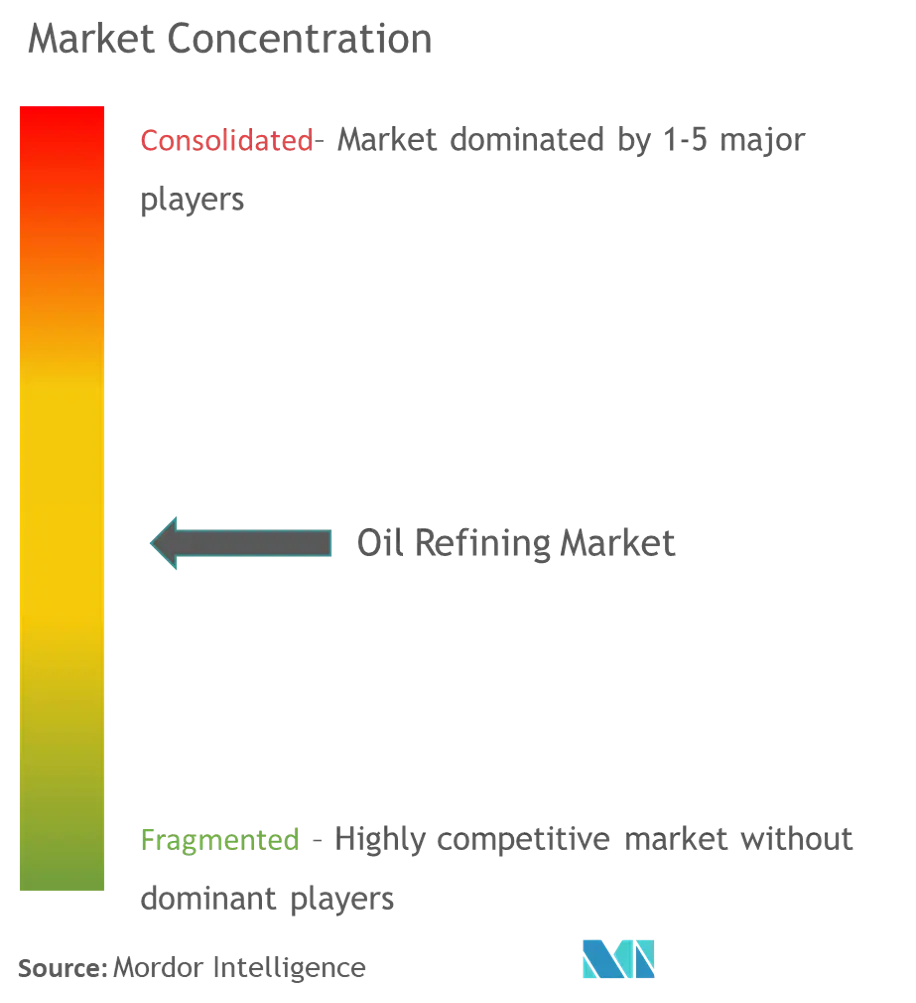Oil Refining Market Size

| Study Period | 2020 - 2029 |
| Base Year For Estimation | 2023 |
| CAGR | 1.30 % |
| Fastest Growing Market | Asia Pacific |
| Largest Market | Asia Pacific |
| Market Concentration | Low |
Major Players*Disclaimer: Major Players sorted in no particular order |
Oil Refining Market Analysis
The oil Refining market is estimated to be at USD 1300 billion by the end of this year and is projected to reach USD 1386.72 billion in the next five years, registering a CAGR of over 1.3% during the forecast period.
- Over the medium term, expanding downstream infrastructure worldwide to meet the increasing demand for refined petroleum products is expected to drive the market during the forecast period.
- On the other hand, the environmental concerns and regulations regarding oil and its products are expected to hinder the market's growth during the forecasted period.
- Nevertheless, many refineries worldwide are aging and require upgrades to improve efficiency, increase capacity, and comply with environmental regulations. Upgrading existing facilities presents opportunities for market studies during the forecasted period.
- Asia-Pacific is expected to remain the major player in the oil refining market. Owing to the upcoming major refinery projects in China and India.
Oil Refining Market Trends
Increasing Global Demand For Refined Petroleum Products To Drive The Market
- The growing consumption of petroleum products, such as gasoline, diesel, jet fuel, and lubricants, is driving the demand for oil refining. Rising population, urbanization, and industrialization contribute to this increased demand.
- The world's population continues to expand, particularly in developing countries. As more people migrate to urban areas, there is a higher demand for transportation fuels, such as gasoline and diesel, to meet the needs of increased vehicular traffic.
- Moreover, economic development and industrialization lead to increased energy consumption. As economies grow, there is a rise in manufacturing activities, infrastructure development, and commercial sectors, all of which require a steady supply of refined petroleum products.
- Additionally, the transportation sector heavily relies on refined petroleum products for various modes of transportation, including cars, trucks, airplanes, ships, and trains. The expanding global transportation network and the increasing mobility needs contribute to the growing demand for refined products.
- According to the International Organization of Motor Vehicle Manufacturers, global vehicle production increased by more than 6% between 2021 and 2022. This growth in vehicle production is expected to increase fuel demand during the forecasted period.
- Furthermore, various countries are investing in expanding their refining capacities to meet the growing demand for petroleum products. Capacity expansions help to bridge the supply-demand gap and ensure energy security.
- For instance, in November 2022, the Nigerian government stated that Petrol Integrated International (GII) had purchased 800 hectares of property in the state for its proposed oil refinery. This added to the growing number of refineries popping up to end Nigeria's decades-long paradoxical condition of being both a large producer of crude oil and a major importer of refined petroleum products.
- Therefore, as mentioned above, the increasing demand for petroleum products is expected to drive the market.

Asia-Pacific to Dominate the Market
- The Asia-Pacific region is home to a significant portion of the world's population, including rapidly developing countries like China and India. These countries' increasing population and urbanization drive the demand for refined petroleum products, including transportation fuels and petrochemical feedstocks.
- Moreover, the Asia-Pacific region has been experiencing robust economic growth over the past few decades. This economic expansion leads to increased industrial activities, infrastructure development, and commercial sectors, which require a substantial supply of refined petroleum products.
- Furthermore, as incomes rise and the middle class expands in countries like China and India, there is a growing demand for automobiles and increased mobility. This trend leads to higher vehicle ownership rates, driving the need for gasoline and diesel fuels, resulting in increased oil refining activities.
- For instance, according to the International Organization of Motor Vehicle Manufacturers, vehicle sales in the Asia-Pacific region increased by more than 4% between 2021 and 2022, signifying the increasing vehicle sales, which drives the demand for petroleum products in the region.
- The Asia-Pacific region has witnessed significant growth in the petrochemical industry, which relies on refined petroleum products as feedstocks. The rising demand for petrochemical products, such as plastics, polymers, and chemicals, supports the region's need for increased oil refining capacity.
- For instance, in August 2022, PetroVietnam, a state-owned Vietnam Oil and Gas Group subsidiary, revealed plans to construct an oil refinery with a crude oil processing capacity of 24 to 26 Mt/year in Ba Ria, Vung Tau province, southern Vietnam. The building process was to be divided into two stages. The first and second phases are anticipated to cost USD 13.5 billion and USD 5 billion, respectively.
- Due to these factors, the Asia-Pacific region is expected to continue being the largest market for the oil refining industry, with significant investments and capacity expansions taking place to cater to the growing demand for refined petroleum products.

Oil Refining Industry Overview
The oil refining market is moderately consolidated. Some of the major players operating in the market (in no particular order) include Exxon Mobil Corporation, Shell PLC, Sinopec Corp., BP PLC, and Saudi Arabian Oil Co.
Oil Refining Market Leaders
-
Exxon Mobil Corporation
-
BP PLC
-
Sinopec Corp.
-
Saudi Arabian Oil Co.
-
Shell PLC
*Disclaimer: Major Players sorted in no particular order

Oil Refining Market News
- May 2023: Rosneft, the Russian energy giant, announced its plans to collaborate with Indian state-owned refiners to establish a new refinery in India. This decision follows the adjustment of the proposed USD 44-billion refinery project on India's western coast by the country's state-run refiners.
- March 2023: Advanced talks were underway between the African Export-Import Bank (Afreximbank) and Senegal's sole oil refiner, Société Africainede Raffinage(SAR), to raise USD 500 million in syndicated funding for further renovating the aging refinery.
Oil Refining Market Report - Table of Contents
1. INTRODUCTION
- 1.1 Scope of the Study
- 1.2 Market Definition
- 1.3 Study Assumptions
2. EXECUTIVE SUMMARY
3. RESEARCH METHODOLOGY
4. MARKET OVERVIEW
- 4.1 Introduction
- 4.2 Refining Capacity and Forecast in million barrels per day (mbpd), till 2028
- 4.3 Refining Throughput in barrels per day, till 2022
- 4.4 Recent Trends and Developments
- 4.5 Government Policies and Regulations
-
4.6 Market Dynamics
- 4.6.1 Drivers
- 4.6.1.1 Increasing Global Demand For Refined Petroleum Products
- 4.6.1.2 Economic Growth And Industrialization
- 4.6.2 Restraints
- 4.6.2.1 Environmental Concerns And Regulations
- 4.7 Supply Chain Analysis
-
4.8 Porter's Five Forces Analysis
- 4.8.1 Bargaining Power of Suppliers
- 4.8.2 Bargaining Power of Consumers
- 4.8.3 Threat of New Entrants
- 4.8.4 Threat of Substitute Products and Services
- 4.8.5 Intensity of Competitive Rivalry
5. MARKET SEGMENTATION - BY GEOGRAPHY Regional Market Analysis {Market Size and Demand Forecast till 2028 (for regions only)}
-
5.1 North America
- 5.1.1 United States
- 5.1.2 Canada
- 5.1.3 Rest of North America
-
5.2 Asia-Pacific
- 5.2.1 China
- 5.2.2 India
- 5.2.3 South Korea
- 5.2.4 Japan
- 5.2.5 Rest of Asia-Pacific
-
5.3 Europe
- 5.3.1 Russia
- 5.3.2 Germany
- 5.3.3 Italy
- 5.3.4 Spain
- 5.3.5 Rest of Europe
-
5.4 South America
- 5.4.1 Brazil
- 5.4.2 Venezuela
- 5.4.3 Argentina
- 5.4.4 Rest of South America
-
5.5 Middle-East and Africa
- 5.5.1 Saudi Arabia
- 5.5.2 Iran
- 5.5.3 Nigeria
- 5.5.4 Kuwait
6. COMPETITIVE LANDSCAPE
- 6.1 Mergers and Acquisitions, Joint Ventures, Collaborations, and Agreements
- 6.2 Strategies Adopted by Leading Players
-
6.3 Company Profiles
- 6.3.1 Exxon Mobil Corporation
- 6.3.2 Shell PLC
- 6.3.3 Sinopec Corp.
- 6.3.4 BP PLC
- 6.3.5 Saudi Arabian Oil Co.
- 6.3.6 Valero Energy Corporation
- 6.3.7 Petroleos de Venezuela SA
- 6.3.8 China National Petroleum Corporation
- 6.3.9 Chevron Corporation
- 6.3.10 Rosneft PAO
- 6.3.11 TotalEnergies SE
- *List Not Exhaustive
7. MARKET OPPORTUNITIES AND FUTURE TRENDS
- 7.1 Upgrading Existing Refineries
Oil Refining Industry Segmentation
Oil refining, also known as petroleum refining, is the industrial process of transforming crude oil (also called petroleum) into various refined products used in everyday life. Crude oil is a complex mixture of hydrocarbons, including gases, liquids, and solids.
The Oil Refining Market is Segmented by Geography (North America, Asia-Pacific, Europe, South America, Middle-East, and Africa). For each segment, the market sizing and forecasts have been done based on refining capacity (in million barrels per day).
| North America | United States |
| Canada | |
| Rest of North America | |
| Asia-Pacific | China |
| India | |
| South Korea | |
| Japan | |
| Rest of Asia-Pacific | |
| Europe | Russia |
| Germany | |
| Italy | |
| Spain | |
| Rest of Europe | |
| South America | Brazil |
| Venezuela | |
| Argentina | |
| Rest of South America | |
| Middle-East and Africa | Saudi Arabia |
| Iran | |
| Nigeria | |
| Kuwait |
Oil Refining Market Research FAQs
What is the current Oil Refining Market size?
The Oil Refining Market is projected to register a CAGR of 1.30% during the forecast period (2024-2029)
Who are the key players in Oil Refining Market?
Exxon Mobil Corporation, BP PLC, Sinopec Corp., Saudi Arabian Oil Co. and Shell PLC are the major companies operating in the Oil Refining Market.
Which is the fastest growing region in Oil Refining Market?
Asia Pacific is estimated to grow at the highest CAGR over the forecast period (2024-2029).
Which region has the biggest share in Oil Refining Market?
In 2024, the Asia Pacific accounts for the largest market share in Oil Refining Market.
What years does this Oil Refining Market cover?
The report covers the Oil Refining Market historical market size for years: 2020, 2021, 2022 and 2023. The report also forecasts the Oil Refining Market size for years: 2024, 2025, 2026, 2027, 2028 and 2029.
Which product segment holds the largest market share in the Oil Refining Industry?
Based on product middle distillates segment holds the largest market share in the Oil Refining Industry.
Oil Refining Industry Report
The global oil refining market is experiencing significant growth and transformation, driven by various factors across different market segments. Middle distillates, including diesel and jet fuel, dominate the product segment due to their essential roles in transportation and other sectors, while gasoline remains a major segment in fuel types, widely used for its high energy density and combustibility. Complexity types like hydro-skimming and deep conversion cater to different needs, addressing cost-effectiveness and stringent product quality regulations respectively. The market is significantly influenced by the transportation sector, driven by the global demand for passenger and commercial vehicles. Technological advancements such as digitalization and automation enhance operational efficiency and productivity in refineries, including some of the biggest oil refineries in the world. Despite challenges like fluctuating crude oil prices and environmental concerns, the market is poised for growth, driven by increasing global demand for refined petroleum products and strategic expansions in refining capacities. For detailed statistics and a historical overview of the oil refining market, consider accessing industry reports from sources like Mordor Intelligence™, which offer comprehensive analysis and market forecast outlooks available as free report PDF downloads.



